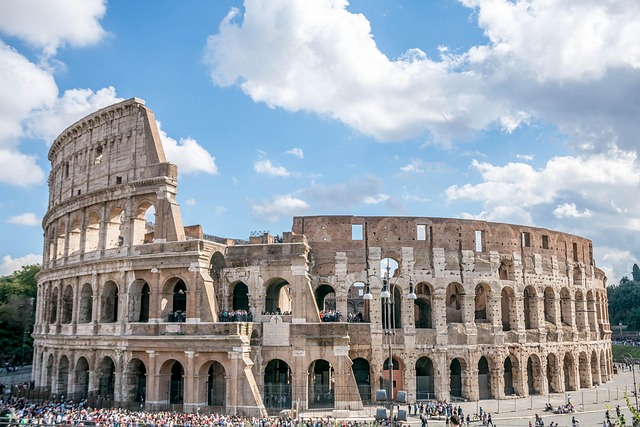The Colosseum, also known as the Flavian Amphitheatre, stands as one of the most impressive and well-preserved monuments from Ancient Rome. Located in the heart of Rome, Italy, the Colosseum is not only an architectural marvel but also a symbol of the grandeur and glory of the Roman Empire. With its rich history, architectural brilliance, and cultural significance, the Colosseum is a must-visit destination for travelers and history enthusiasts from around the world.
What is the Colosseum?
The Colosseum is an ancient amphitheater built by the Roman emperors during the Flavian Dynasty, hence the name Flavian Amphitheatre. Construction of the Colosseum began under Emperor Vespasian in 70 AD and was completed by his son, Emperor Titus, in 80 AD, with further modifications under Emperor Domitian. This monumental structure was used for various public spectacles, such as gladiatorial contests, animal hunts, mock sea battles, and executions, making it a center of Roman entertainment.
The Colosseum could hold up to 50,000 spectators and was the largest amphitheater in the Roman world. It was used for nearly 400 years before it eventually fell into disrepair, largely due to earthquakes, looting, and the shifting of societal needs.
History of the Colosseum
The Colosseum was primarily built to serve as a venue for public entertainment and to solidify the emperor’s connection with the people. The arena was a place where the Roman populace could watch gladiatorial games, exotic animal hunts, and other performances. These events were held to celebrate military victories, royal birthdays, and other important occasions.
- Construction and Design: The Colosseum was constructed using a combination of stone, concrete, and brick, showcasing the Romans’ incredible engineering prowess. The outer wall is made of travertine limestone, while the inner part of the arena features a complex system of vaults and arches. The structure is elliptical in shape, with a length of 189 meters and a width of 156 meters.
- Entertainment and Spectacles: The games at the Colosseum were brutal and often violent. Gladiators, who were typically slaves or prisoners of war, fought each other or wild animals in the arena to entertain the masses. Mock naval battles were also staged in the Colosseum by flooding the arena, and executions were carried out as part of the shows. The games were a way for emperors to display their power and control over both the population and the conquered territories.
- The Decline: After the fall of the Western Roman Empire in the 5th century, the Colosseum fell into disuse. Earthquakes in 847 AD and 1231 AD caused significant damage to the structure, and much of the stone was stripped for use in other construction projects. The Colosseum was also used as a Christian sanctuary and later as a fortress, which led to further deterioration.
Key Features of the Colosseum
- Size and Structure: The Colosseum stands 48 meters (157 feet) tall, with a length of 189 meters (620 feet) and a width of 156 meters (510 feet). It consists of four levels, with the top level originally reserved for lower-class spectators, while the first few levels were for the elite and the emperor.
- The Arena: The arena of the Colosseum is the heart of the structure. It is an elliptical shape, measuring 83 meters by 48 meters (272 by 157 feet). The floor of the arena was originally made of wooden planks and covered with sand to absorb blood from the battles. Beneath the arena, there was a complex network of underground chambers, where animals, slaves, and gladiators were kept before the events.
- The Hypogeum: The Hypogeum refers to the underground level of the Colosseum, which contained passageways, trapdoors, and rooms for gladiators and animals. This area is crucial for understanding how the Colosseum was used, as it allowed for dramatic entrances and surprises during the events.
- The Seating Arrangement: The seating inside the Colosseum was carefully organized based on social class. The emperor had a special seat in the imperial box, located on the podium level. The senators sat in the front rows, while the common people and slaves were seated at the top.
Why is the Colosseum Important?
The Colosseum holds immense historical, cultural, and architectural significance. Here’s why it remains one of the world’s most iconic landmarks:
- A Monument to Ancient Roman Engineering: The Colosseum represents the pinnacle of Roman engineering. Its massive size, intricate design, and use of advanced construction techniques such as the Roman arch and concrete are a testament to the ingenuity of Roman architects.
- Symbol of Roman Power and Culture: The Colosseum symbolizes the power of the Roman Empire, demonstrating the Romans’ ability to control and entertain their vast population through grand spectacles. It also reflects the Romans’ deep connection with public life and their use of entertainment as a political tool.
- A Window into Roman Entertainment: The Colosseum provides modern-day visitors with a glimpse into the brutal and captivating forms of entertainment that were central to Roman society. The gladiatorial games, which were held here, offer insight into the values, class structure, and practices of Ancient Rome.
- UNESCO World Heritage Site: The Colosseum was recognized by UNESCO as a World Heritage Site in 1980. It continues to be one of the most popular tourist destinations in Italy, drawing millions of visitors each year.
Visiting the Colosseum
When planning your visit to the Colosseum, here are some essential tips:
- Best Time to Visit: The best time to visit the Colosseum is during the spring (April to June) and autumn (September to October), when the weather is mild, and the crowds are smaller. Summer months (July and August) can be very hot and crowded, especially in Rome.
- How to Get There: The Colosseum is located in the heart of Rome, and it is easily accessible via public transport. You can reach it by metro, bus, or walking from many central areas of the city.
- Tickets and Entry: Tickets to the Colosseum can be purchased in advance online or at the entrance. There are several ticket options available, including guided tours and skip-the-line tickets. Make sure to plan ahead, as the Colosseum is one of the most visited sites in Rome.
- Guided Tours: To truly appreciate the history and significance of the Colosseum, consider taking a guided tour. Knowledgeable guides can provide detailed insights into the history of the site, the events that took place there, and its cultural impact on Rome and the world.
Fun Facts About the Colosseum
- Naval Battles: The Colosseum was occasionally flooded to stage mock naval battles. This practice was known as naumachia, where participants would simulate naval warfare for the entertainment of the crowd.
- Gladiator Fights: Gladiators were often slaves or prisoners of war, but some chose to fight voluntarily for fame and prize money. These fighters were highly trained and followed strict codes of conduct during their battles.
- Used as a Quarry: After the Colosseum ceased to be used for entertainment, it was stripped of much of its materials, which were repurposed for the construction of other buildings, including St. Peter’s Basilica.
- The First Public Arena: The Colosseum is often considered the first public arena in history, offering entertainment to the masses regardless of their social class.
Conclusion: The Enduring Legacy of the Colosseum
The Colosseum remains one of the most recognizable symbols of Ancient Rome and continues to attract millions of visitors each year. Its monumental scale, historical significance, and cultural impact make it a must-see destination for anyone interested in exploring the wonders of the ancient world. A visit to the Colosseum offers an unforgettable experience, providing a window into the lives of the Romans and the splendor of their civilization.
For anyone visiting Rome, a trip to the Colosseum is an essential part of the journey. Step into the past and experience the grand spectacle of Ancient Rome that continues to echo through the centuries.






